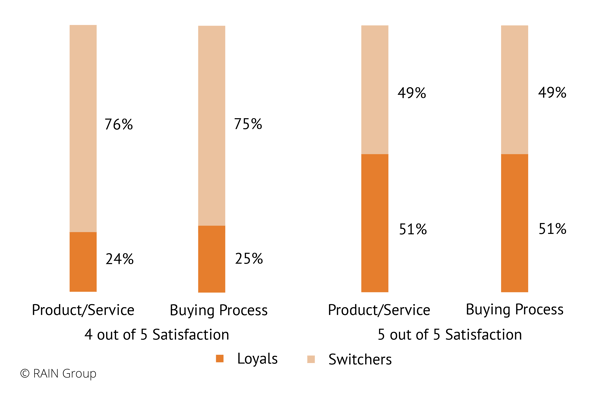Client loyalty can make or break a company. Loyalty is tied to buyer satisfaction and their experience buying from you—but it’s tough to earn.
Fred Reichheld, author of The Loyalty Effect and creator of the Net Promoter System, found that most corporations lose 50% of their customers every 5 years, 50% of employees in 4 years, and 50% of investors in less than one year.
It's not surprising. It isn't easy to achieve the highest levels of satisfaction and relationship strength needed to keep clients loyal at a higher clip than average.
There's a lot of research supporting the link between loyalty and overall client satisfaction after they buy.
However, it’s not just about what happens after the buyer buys. The RAIN Group Center for Sales Research has found a link between loyalty and satisfaction with the buying process itself. Loyalty doesn't only come from the buyer's satisfaction with your product or service. Satisfaction before they buy is just as important.
"Loyals" are buyers who definitely or probably will not switch providers in the future.
"Switchers" might, definitely, or probably will switch.
Satisfaction with the Buying Process Impacts Loyalty

As you can see, the buyer's experience in the buying process is just as predictive of ongoing loyalty as product or service satisfaction.
Read on to learn how to manage a sale from the start to improve your chances of acquiring loyal buyers.
What’s the Impact of Client Loyalty?
Finding ways to promote and improve loyalty can have an outsized impact on your business. Loyal buyers are more likely to refer others and assist with your broader sales strategy (providing testimonials, acting as references, etc.). Many of the tactics involved in referral generation—implementing feedback, establishing partnerships, and educating clients about what’s possible—are also steps to building loyalty.
6 Ways to Build Client Loyalty in Sales
So how do you ensure that clients are content with both the buying process and the end result?
You add value. And that’s what insight selling is all about.
Through our research and practice in the field of strategic account management, we've found six areas of client retention that can almost universally be improved.
1. Be proactive
If you want to become essential to your clients, you have to be proactive. Surprise and delight the buyer. Take the initiative to enhance the value you bring to them. This may mean getting the buyer a resource before they ask for it or before they even know they need it. It may mean developing a custom solution for them. It may mean facilitating introductions and hosting high-level retreats among executives in complementary industries.
This proactivity starts early in the selling process. By leading a comprehensive needs discovery that digs deep into the buyer’s underlying wants and needs, you go beyond just providing solutions and demonstrate your understanding of your buyer and their organization.
2. Be prepared
Do your homework. Research which ideas and insights might be relevant for buyers. Follow the company’s internal and external news. Track stakeholders. Keep up with changes in the industry and the competitive environment.
Then, attend to point #1. Bring these insights to clients proactively. An email or call as simple as, “How are you addressing the new regulations around ABC? I have a few ideas for you as you develop your strategy. Can we meet to discuss?” can go a long way.
You’ll also need to understand how the buying process runs parallel to the selling process. When you know what’s necessary in each phase, you can adapt your approach and advance the sale as needed.
3. Consider the buyer’s whole team
How do the stakeholders on their team view the relationship? Maybe a few people perceive it to be essential, but maybe others don’t even know you. If they’re important, that’s a vulnerability you need to address.
This is where you want someone—a champion—in their organization to advocate for you. You can’t be in the room for every conversation your buyer has about the sale, but you can do whatever’s possible to make sure somebody will speak on your behalf.
Knowing how to connect to and influence decision-makers in the buyer’s organization can prevent missteps and keep the sale on track.
4. Make sure what you're selling is adopted and used as much as possible
If clients use your products and services, they’ll value them. They’ll neither want nor need to switch. If someone suggests switching, they might say, “Everyone uses this. It would be a colossal challenge to change.” People don’t like change. The more your product or service is embedded in their culture and behavior, the less likely they’ll change.
If adoption and use are low, do something about it. Help ease adoption or create a proven process for the buyer to use. Make time to train the buyer’s leadership on how to implement your solution.
5. Embed your company
Can you negotiate for long-term, sole-source contracts? Offer clients an attractive long-term license for your technology or intellectual capital? Structure contracts so the more they use your services or products, the more advantages they get (such as pricing, preferred treatment, and added value)?
Embedding yourself in the organization inspires the client to use you more and competitors less.
6. Build trust
When buyers trust you, they depend on you, listen to you, give you access, and spend time with you. In our What Sales Winners Do Differently research, we found that building trust is one of 6 key drivers of client loyalty.
Build Loyalty from the First Touch
Once you have a customer onboard, strategic account management yields massive returns if done well. Sellers should still strive to embody value and proactively build buyer satisfaction during the sales process. This starts with knowing your buyer, leading a thorough needs discovery, and matching your selling process with their buying process.
It’s just like a golf swing—from your stance to your follow-through, getting each step of the process right is critical.







